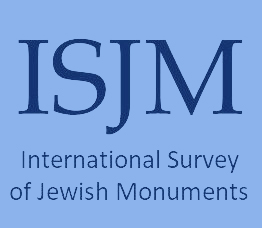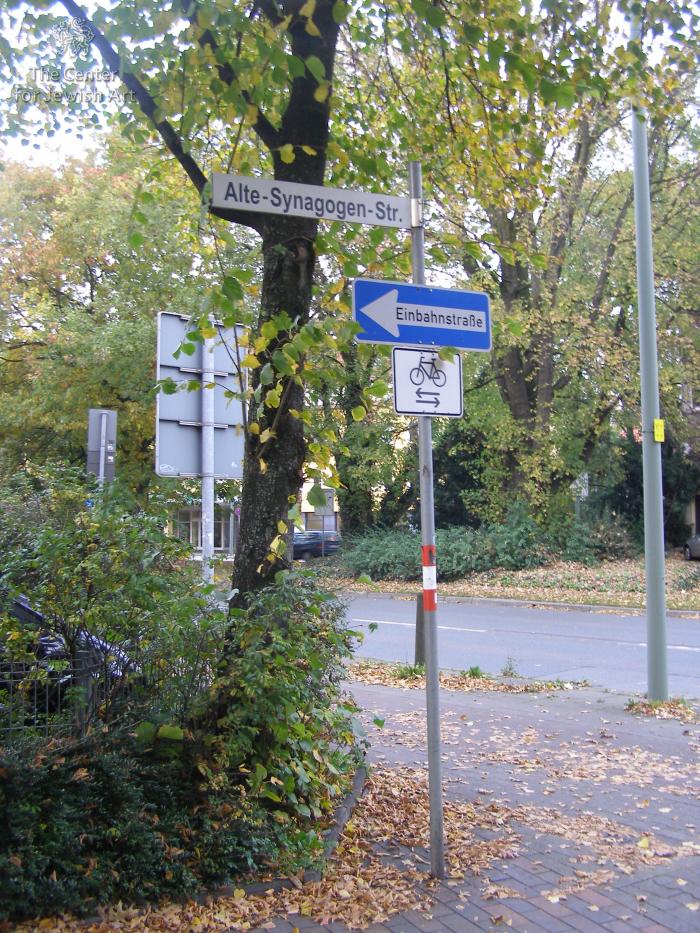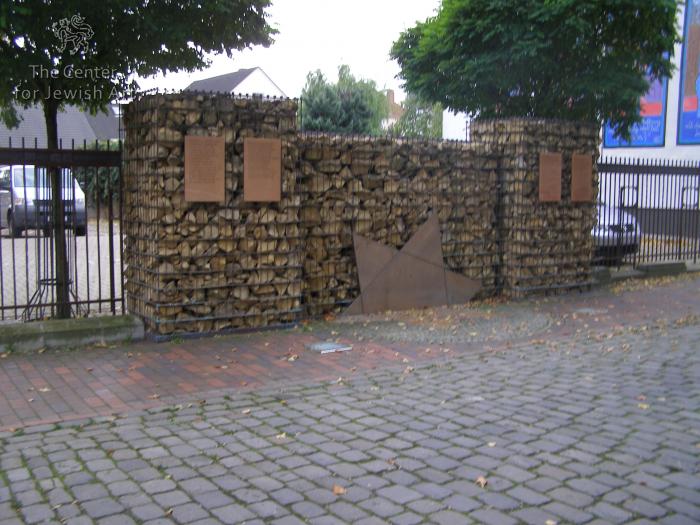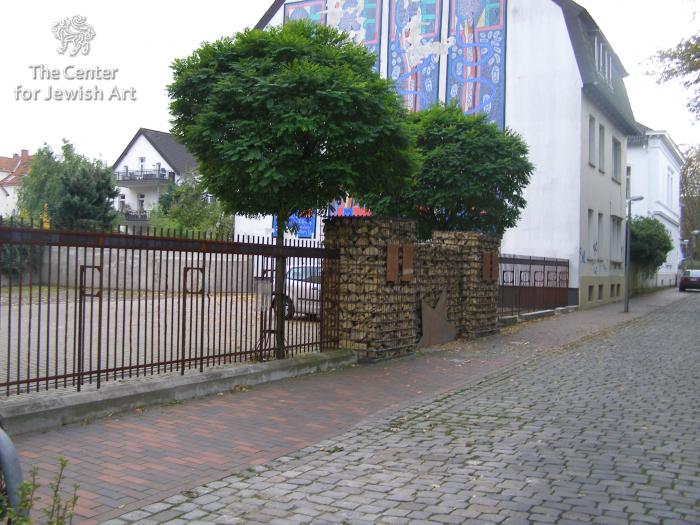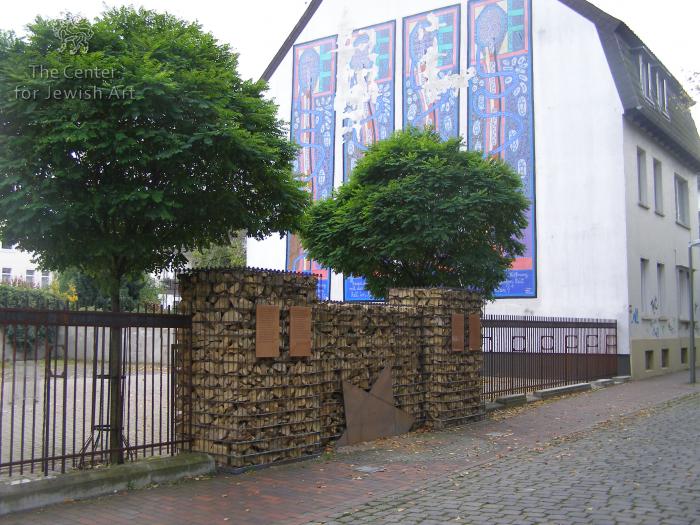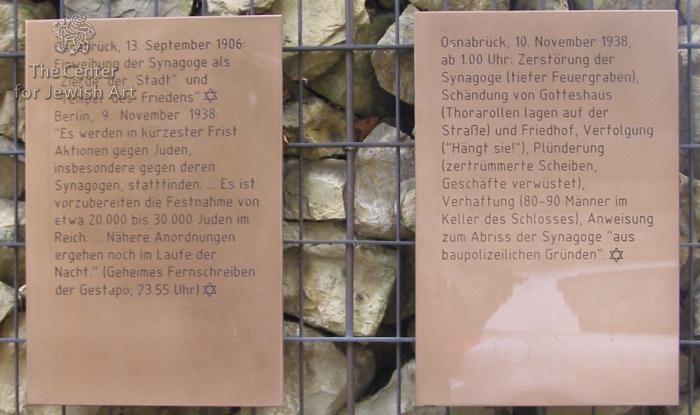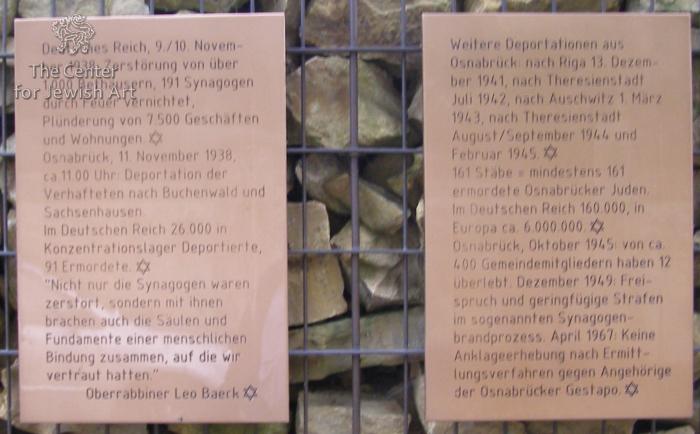Obj. ID: 49087 Holocaust Memorial at the Site of the Synagogue in Osnabrück, Germany
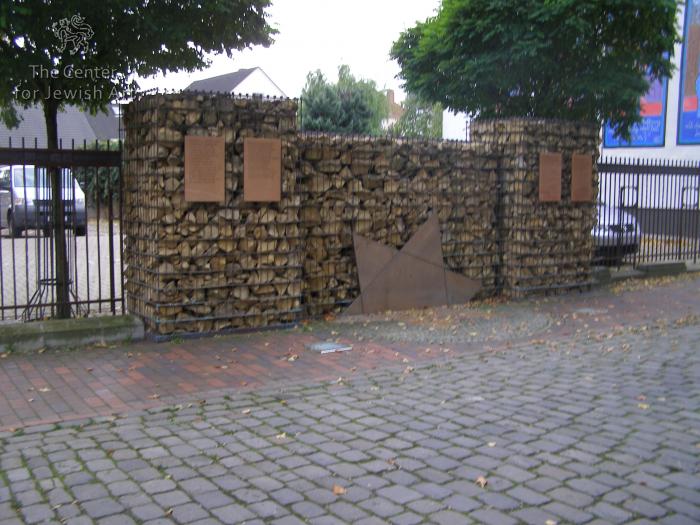
Memorial Name
Old Synagogue Memorial
Who is Commemorated?
The Old Synagogue that stood at this site.
Description:
The monument is flush with the brick sidewalk on the site of the former synagogue of Osnabruck. It consists of a tri-partite gabion wall, attached to a long metal fence that closes off the property. A gabion (cage) wall consists of rubble enclosed in a metal cage. The form is meant to recall the facade arrangement of the 1906 synagogue – a central bay flanked by protruding stair towers. The stone inside the gabion is meant to suggest the rubble of the destroyed synagogue, it appears to not be original to the building, but new “broken” stone brought for memorial purposes.
Attached to the metal cage near the top are four rectangular metal plaques with historical texts that narrate the process of exclusion, persecution, deportation, and murder of Jews of Osnabrück. These plaques are paired, with two on each “tower.” A large metal Magen David (made of either cut steel plate or bronze) fills the lower half of the central bay. The star is folded, so that part is laid into a semi-circle of square cobblestones that is set into the brick pavement in front of the monument. Part of the star is vertical and attached to the metal cage. The star is tilted, so it looks like it has fallen, or is in the process of falling, off the wall and onto the pavement.
The text of the monument refers to 162 fence posts that commemorate 162 murdered people. These must be the vertical elements of the gabion, each of which terminates as a small round cap at the top of the cage.
Inscriptions
German
Osnabrück, 13. September 1906:
Einweihung der Synagoge als
„Zierde der Stadt“ und
„Tempel des Friedens“ [Magen David]
Berlin, 9 November 1938:
„Es werden in kürzester Frist
Aktionen gegen Juden,
insbesondere gegen deren
Synagogen, stattfinden. ...Es ist
Vorzubereiten die Festnahme von
Etwa 20.000 bis 30.000 juden im
Reich. ,,,Nähere Anordnungen
Ergehen noch im Laufe der
Nacht.“ (Geheimes Fernschreiben
Der Gestapo, 23.55 Uhr) [Magen David]
Translation: Osnabrueck, September 13, 1906: Dedication of the synagogue as "Ornament of the City" and "Temple of Peace" Berlin, November 9, 1938: “There will take place in the shortest possible time actions against Jews, especially against their synagogues. ...It is to prepare the arrest of about 20,000 to 30,000 Jews in the Reich. ,,, Further arrangements will still occur in the course of the night.” (Secret telex The Gestapo, 11:55 p.m.)
German
Osnabrück, 10 November 1938,
ab 1.00 Uhr: Zerstörung der
Synagogue (tiefer Feuergraben),
Schändung von Gotteshaus
(Thorarollen lagen aud der
Strasse) und Friedhof, Verfolgung
(Hängt sie!'), Plünderung
(zertrummerte Scheiben, Geschäfte verwüstet),
Verhaftung (80-90 Männer im
Keller des Schlosses), Anweisung
zum Zbriss der Synagogue "aus
baupolizeilichen Gründen".
Translation: Osnabrueck, November 10, 1938, from 1.00 a.m.: Destruction of the Synagogue (deep fire trench), desecration of the house of worship (Torah scrolls lay on the street) and cemetery, persecution (Hang them!'), plunder (smashed windows, shops devastated), Arrest (80-90 men in the basement of the castle), instruction for the demolition of the synagogue [due to] "building regulations".
German
Deutsches Reich, 9/10 Novem-
ber 1938: Zerstörung von über
1.000 bethäusern, 191 Synagogen
durch Feuer vernichtet,
Plünderung von 7.5000 Geschäften
Und Wohnungen.
Osnabrück 11 November 1938,
Ca. 11.00 Uhr: Deportation der
Verhafteten nach Buchenwald und
Sachsenhausen.
Im Deutschen Reich 26.000 in
Konzentrationslager Deportierte,
91 Ermordete.
“Nicht nur die Synagogen waren
Zerstört, sondern mit ihnen
Brachen auch die Säulen und
Fundamente einer menschlichen
Bindung zusammen, auf die wir
Vertraut hatten.”
Oberrabbiner Leo Baeck
Translation: Osnabrueck 11 November 1938, Approx. 11.00 a.m.: Deportation of the arrested to Buchenwald and Sachsenhausen. In the German Empire 26,000 concentration camp deportees, 91 murdered. “Not only were the synagogues destroyed, but with them also broke the pillars and foundations of a human bond in which we had together trusted.” - Chief Rabbi Leo Baeck
German
Weitere Deportationen aus
Osnabrück nach riga 13. Dezem-
ber 1941, nach Theresienstadt
Juli 1942, nach Auschwitz 1. Marz
1943, nach Theresienstadt
August/September 1944 und Februar 1945.
161 Stäbe = mindestens 161
ermordete Osnabrücker Juden.
Im deutschen Reich 160.000, in
Europa ca. 6.000.000.
Osnabrück, oktober 1945: von ca.
400 Gemeindemitgliedern haben 12
überiebt. Dezember 1949: Frei-
spruch und geringfügige Strafen
im sogenannten Synagogen-
brandprozess. A[rol 1967: Keine
Anklageerhebung nach Ermitt-
lungsverfahren gegen Angehörige
der Osnabrücker Gestapo.
Translation: More deportations out of Osnabrück to Riga on 13 December 1941, to Theresienstadt in July of 1942, to Auschwitz on March 1st, 1943, to Theresienstadt in August/September 1944 and February 1945. 161 bars = at least 161 murdered Osnabrück Jews. In the German Reich 160,000, in Europe approx. 6,000,000. Osnabrück, October 1945: from approx. 400 community members 12 returned. December 1949: Free verdict and minor penalties in the so-called synagogue burning. April 1967: No indictment after investigation and criminal proceedings against relatives of the Osnabrück Gestapo.
Commissioned by
Gesellschaft für Christlich-Jüdische Zusammenarbeit
(Society for Christian-Jewish Cooperation)
| Alte-Synagogen-Strasse (formerly Rolandstrasse) 3–5
Stone (rubble)
The Old Synagogue was designed by Cologne architect Sigmund Münchhausen and dedicated in 1906. The synagogue was set on fire on November 9, 1938, (Kristallnacht) and complete demolition was ordered the same day. The multi-synagogue was notable for its prominent dome. A Jewish school was also on the community property in a separate four-story building that also contained apartments.
On the night of November 9-10, 1938 (Kristallnacht or Reichspogromnacht), the synagogue was desecrated, looted, and then set on fire by SA troops. The local fire brigade arrived, but only protected the surrounding buildings. 90 community members were detained in the cells of the Gestapo cellar and a few days later sent to the Buchenwald concentration camp. Though the fire did not completely destroy the synagogue, Mayor Erich Gaertner cited "building policy reasons" to order the synagogue’s demolition the same day as the arson.
The Jewish community in Osnabrück was re-established in October 1945 and the now-vacant property was temporarily returned “until the final transfer of ownership.” The school building was used as a prayer and residential building. In 1954 the property was purchased from the Jewish Trust Corporation and added an annex to the adjacent government building on Alte-Synagogen-Straße.
The first memorial complex on the site of the destroyed synagogue was built in 1949/1950. In 1978 three memorial plaques were attached to the extension of the government building on the side facing Alte-Synagogen-Straße. a section of Rolandstrasse renamed in 1978. The location of the previous memorial plaques on a government building was criticized, and in 2004 a new more visible “Old Synagogue Memorial” was built on the foundations of the former Jewish school, and more than 120 vocational students and trainees took part in its construction.
The Jewish Community built a new synagogue in 1967-69 in the Weststadt district, designed by Frankfurt architect Hermann Guttman, with a community center and apartments. This was expanded between 2008 and 2010.
Gander, Michel. Interests in the Osnabrück synagogue property: Gestapo, Lord Mayor and District President In: Gestapo basement memorial in Osnabrück Castle, Osnabrück 2003.
Von Rainer Lahmann-Lammert. “Wie Osnabrück die jüdische Gemeinde in den Ruin trieb,” noz.de, March 6, 2015, https://www.noz.de/lokales/osnabrueck/artikel/553450/wie-osnabruck-die-judische-gemeinde-in-den-ruin-trieb#gallery&0&0&553450 (accessed May 17, 2023)
“Wikimedia Commons : Old Synagogue” [collection of pictures, videos and audio files], https://commons.wikimedia.org/wiki/Category:Alte_Synagoge_(Osnabr%C3%BCck)?uselang=de (accessed May 17, 2023)



